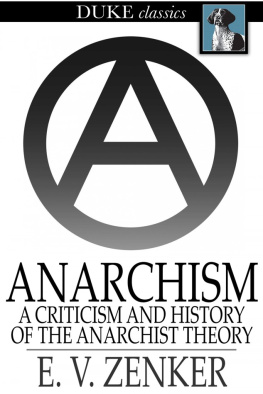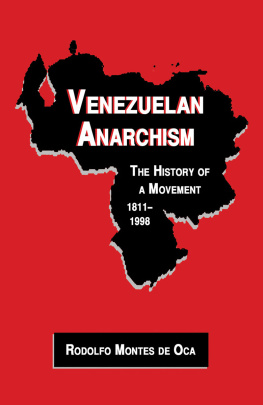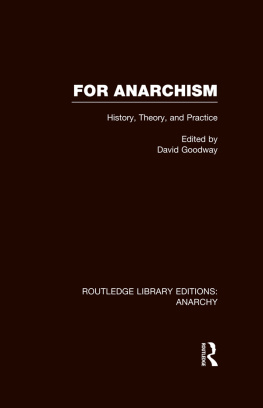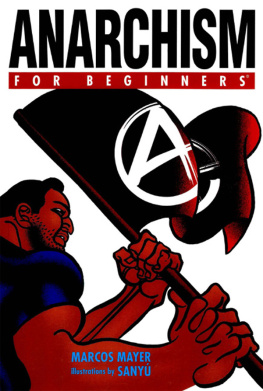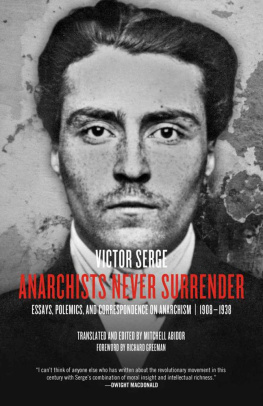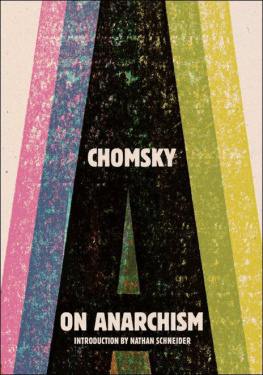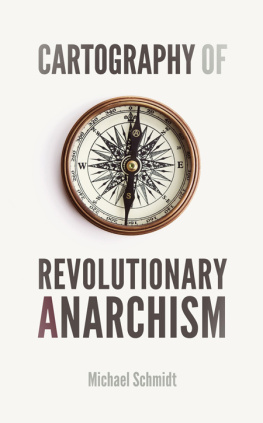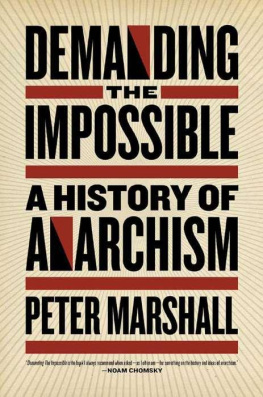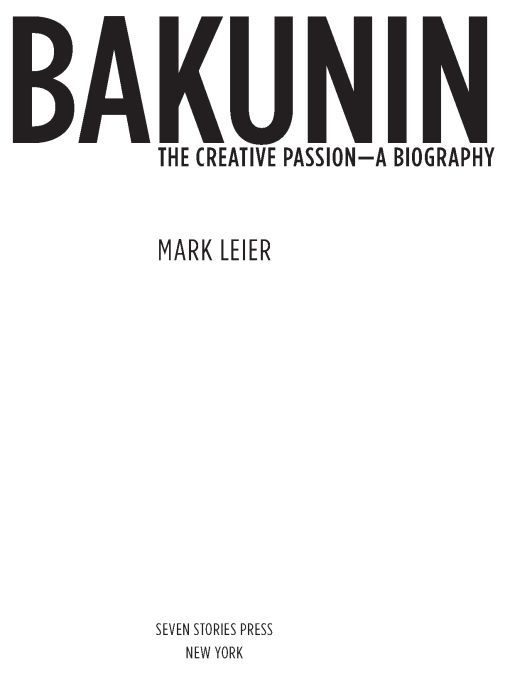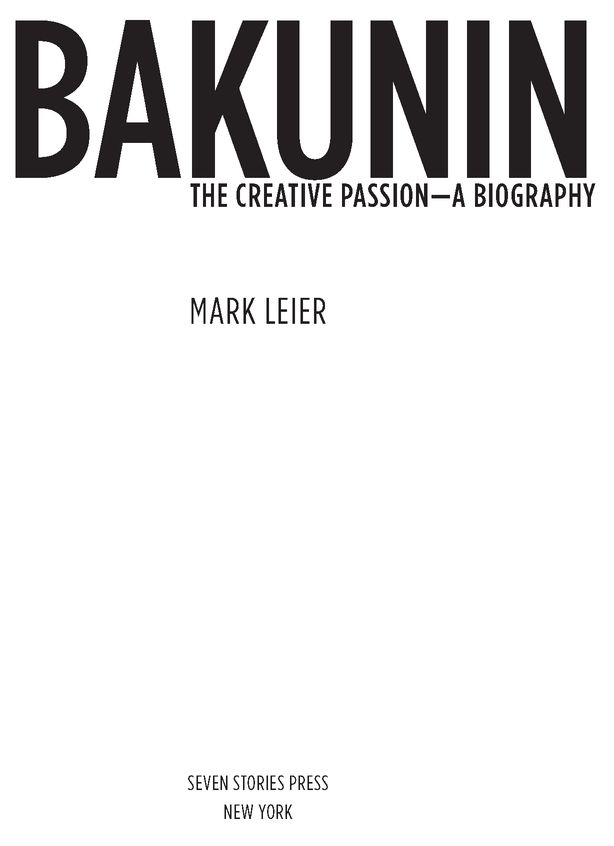Table of Contents
Praise for Bakunin:
Mark Leier has produced the finest work on Bakunin in the English languagea tremendously witty, informative, and insightful study that restores to Bakunin his humanity as well as his intellectual and political significance.
PAUL MCLAUGHLIN, author of Mikhail Bakunin: The Philosophical Basis of His Anarchism
A modern biography of the father of anarchism is overdue: Mark Leiers admirable study tells the colorful, rebellious, and often outrageous story of the eccentric Bakunin in a style that is entertaining, scholarly, and fresh, a biography that not only reassesses this fascinating and important character but also provides the biography of the forgotten ideology of anarchism itself.
SIMON SEBAG MONTEFIORE, author of Stalin: The Court of the Red Tsar
The time for Bakuninthe real one, not the caricaturehas come again, and Mark Leier has given us just the history that we need. Wonderfully written, scholarly but also packed with fascinating tales and fresh revelations, Bakunin: The Creative Passion is passion with purpose.
PAUL BUHLE, coeditor of Encyclopedia of the American Left and Wobblies! A Graphic History of the Industrial Workers of the World
The life of Bakunin (1814-1876), the Russian architect of the anarchist movement, provides a surprisingly enjoyable introduction to the tumult of nineteenth-century radicalism... A chapter on the roots of Bakunins thought in German idealism provides a lucid eight-page precis of Hegels ideas thats actually fun to read. The feud between Bakunin and Marx gets ample space... [Leier] brings welcome consideration to the real merits of the movements theory.
Publishers Weekly
ALSO BY MARK LEIER
Rebel Life: The Life and Times of Robert Gosden, Revolutionary, Mystic, Labour Spy
Red Flags and Red Tape: The Making of a Labour Bureaucracy
The Light at the End of the Tunnel: The Tunnel and Rockworkers Union, Local 168 (with M. C. Warrior)
Where the Fraser River Flows: The Industrial Workers of the World in British Columbia
To the East Kings Road Commune
INTRODUCTION
The war was supposed to be over. In 1989 the Berlin Wall was torn down and with it went the fabled evil empire of the Soviet Union. For many observers, this meant more than the collapse of a rival power and the end of the Cold War; it was the end of history itself. They didnt mean that the past had ceased to exist or that societies would cease to change. Their point was both more metaphysical and more banal. Simply put, history was a heroic struggle between capitalism and communism. Locked in mortal combat, the two opposing systems used ideas, ballots, bullets, even the threat of nuclear Armageddon, to seek the winning advantage. The struggle, on the high plane of ideals and literature, in steaming jungles and on dark, rain-slicked streets, sometimes open, sometimes hidden, propelled change over timehistoryas humanity lurched desperately from left to right to an uncertain future. But with the collapse of the Soviet Union, the West had won, using, in the words of G. B. Trudeau in his comic strip, Doonesbury, the basics: hard currency, cheap wheat, and good rock n roll. History as cataclysmic clash was over. There was some mopping up to be done in the hinterlands, but soon they too would be quiet. At long last the business of business could proceed smoothly, without interference or distraction, because there was no alternative to capitalism.
That illusion was shattered on the streets of Seattle in November 1999. Five days of protest against the World Trade Organization showed that dissent was possible and that resistance was not futile. Students, trade unionists, environmentalists, indigenous people, farmers, and consumers raised their fists and voices against globalization, the surveillance state, and business as usual. Seattle was a symbol that the struggle continued, and that history had begun again.
The five days that shook the world were led by a movement many thought had vanished with the flip of the switch that electrocuted Nicola Sacco and Bartolomeo Vanzetti in Boston in 1927. For the first time in years, anarchism was a political force that rallied thousands under its black flag. As protest flashed around the globe, from Melbourne to Mexico City to Prague to Quebec City to Nice to Genoa to Miami, the anarchist Black Bloc and White Overalls groups generated a frisson of fear and shock. Anarchism made the six oclock news. It even invaded American prime time as Toby Ziegler deplored anarchist wannabes on The West Wing and Tony explained Sacco and Vanzetti to the rest of The Sopranos. The media rushed to explore the phenomenon, and articles on anarchism appeared in The Economist, The Washington Post, The Wall Street fournal, The New York Times, National Post, Harpers, and Time. The Utne Reader, a sort of Readers Digest for New Agers, even warned its readers that You may be an anarchistand not even know it.
The media, however, did more to obscure anarchism than to explain it. Focusing on the street fighting and confrontations with police, mainstream commentators were unable to understand what anarchism was or why a philosophy with roots in the nineteenth century resurfaced with such power at the dawn of the new millennium. Their inability to understand anarchism is not surprising. It is often misunderstood by its opponents and even by its advocates. The word itself has long been separated from its real meaning of rule by no one. A check of anarchism and its cognates in thesauruses from the 1935 Rogets to the one in Microsoft Word 2000 reveals misleading synonyms such as evildoer, destroyer, disobedience, disorder, and mayhem. High and popular cultures alike have contributed to the misunderstanding. W. B. Yeats, appalled at the post-apocalyptic world of the Great War and the popular demand for sweeping social change that followed, whined that things fall apart; the center cannot hold; mere anarchy is loosed upon the world. Since the nineteenth century, the anarchist has been pictured as a wild-eyed bohemian, clothed in a wide-brimmed, pointed felt hat and a long black cape that concealed a round bomb with a sputtering fuse. Bertram Lamb and A. B. Paynes popular comic strip in the British Daily Mirror newspaper of the 1920s and 1930s, Pip, Squeak, and Wilfred, featured such a character, named Popskiread foreigner, Bolshevik, eviland the strip and the animated short films that followed popularized the portrait. Robin Williams gave a dynamiteand dynamitedperformance of just such a figure in the 1996 film adaptation of Joseph Conrads The Secret Agent. The old image has been updated, with anarchists now portrayed clad in black fatigues, their faces hidden by woolen balaclavas, as they trash the storefronts of McDonalds and Starbucks outlets and fight with police. Such inaccurate stereotypes persist, even in contemporary fiction.
Other events, however, soon diverted attention away from demonstrations and street protests. After 11 September 2001, the experts now looked to anarchism for explanations of terrorism. David Ignatius, in a widely reprinted editorial, wrote that while bin Ladens texts are couched in the language of Islam, they read like the flowery manifestos of the elitist bomb throwers of the nineteenth century like Prince Peter Kropotkin or Mikhail Bakunin. Lewis Lapham drew a straight line from Bakunin to bin Laden via Timothy McVeigh, who was executed for the Oklahoma City bombing, and Ted Kaczynski, better known as the Unabomber. John le Carre, in an otherwise extremely thoughtful and insightful article, concluded that Mr. Bakunin in his grave and Mr. bin Laden in his cave must be rubbing their hands in glee as security forces were expanded and civil liberties were curtailed in the panic that ensued in the aftermath of the WTC bombing. In Canada, the mild-tempered Ian Brown concluded in the pages of the


